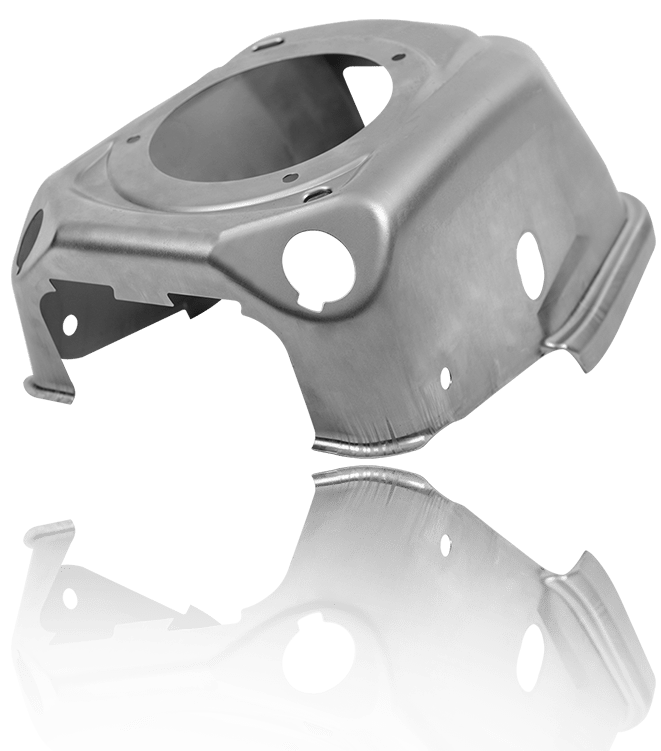Greatest Guide to Metal Stamping Techniques and Applications
Greatest Guide to Metal Stamping Techniques and Applications
Blog Article
Metal Marking Technologies: Elevating Production Processes for Superior Results
In the realm of producing processes, steel stamping has actually long been a keystone method for creating a range of accuracy parts. With the unrelenting march of technical advancement, the landscape of metal stamping is undertaking a significant improvement.
Evolution of Metal Stamping Techniques

In addition, improvements in material scientific research have led to the growth of high-strength alloys that can currently be effortlessly marked into intricate shapes, accommodating a broader variety of commercial applications. The assimilation of robotics and fabricated intelligence has additionally maximized the marking process by enhancing rate and precision while lowering the risk of human mistake.

Effect of Advanced Products
Have sophisticated materials transformed metal stamping processes significantly in the manufacturing sector? By utilizing materials such as high-strength alloys, advanced composites, and ingenious coverings, metal stamping procedures can currently create components that are lighter, more powerful, and a lot more resilient than ever previously.
These sophisticated materials offer remarkable mechanical residential or commercial properties, corrosion resistance, and thermal security, allowing manufacturers to fulfill the needs of contemporary industries such as aerospace, automotive, and electronics. In addition, using advanced materials in steel marking has actually promoted the production of intricate geometries and detailed designs that were previously unattainable through typical approaches.
Furthermore, the execution of advanced products has actually resulted in minimized product waste, lower manufacturing prices, and shorter preparations, making metal stamping procedures much more economical and lasting. As innovation remains to advancement, the effect of innovative materials on steel marking procedures is expected to drive more technology and boost the competitiveness of makers in the global market.
Automation in Steel Stamping
The evolution of steel stamping processes driven by the integration of advanced products has set the phase for substantial innovations in automation within the production market. Automation in metal marking has actually changed manufacturing procedures, boosting performance, accuracy, and total output high quality. Via the utilization of robotics, sensors, and computer-controlled systems, tasks that were lengthy and once hands-on can currently be performed with exceptional rate and precision.
Automation in metal stamping not only speeds up manufacturing rates yet likewise guarantees consistency in the manufacturing process. By lessening human intervention, the danger of errors is substantially decreased, bring about greater levels of product uniformity and dependability. Additionally, automation allows makers to take on complex stamping jobs that would be challenging or unwise to achieve manually.
Moreover, automation in steel stamping contributes to a safer working setting by minimizing the requirement for workers to take part in recurring or unsafe tasks - Metal Stamping. This change in the direction of automation not only enhances efficiency yet likewise leads the way for the future of manufacturing, where modern technology plays a central duty in driving functional quality
Top Quality Control and Evaluation Systems
With a concentrate on precision and integrity, quality control and assessment systems play an important duty in making certain item quality in metal stamping procedures. These systems are made to monitor every stage of production, from material evaluation to the end product, to assure that all components satisfy the required requirements. By implementing advanced innovations such as optical inspection systems, coordinate gauging makers (CMM), and automated assessing devices, producers can discover even the tiniest variances in measurements, surface area high quality, and overall stability of stamped parts.

Sustainability Practices in Metal Stamping
Building upon the foundation of accuracy and reliability established via quality assurance and evaluation systems, the combination of lasting practices in metal stamping processes is increasingly becoming a focal point for makers looking for to lessen ecological influence and maximize resource use. Sustainability methods in steel marking encompass a variety of initiatives focused on lowering waste generation, power usage, and greenhouse gas emissions throughout the production process.
One trick element of sustainability in metal marking is the fostering of environmentally friendly products and modern technologies that promote recyclability and waste decrease. By making use of recycled products and implementing energy-efficient machinery, producers can decrease their carbon footprint and add to an extra lasting manufacturing cycle. In addition, maximizing manufacturing processes to minimize material waste and energy usage not only benefits the setting but additionally results in set you back savings for businesses in the lengthy run.
Additionally, the execution of sustainable techniques in metal stamping can boost brand name credibility and attract eco conscious consumers. As sustainability remains to obtain importance in the manufacturing sector, incorporating eco-friendly initiatives into metal marking processes is essential for long-term success and competition out there.
Conclusion
Finally, steel stamping techniques have actually considerably evolved gradually, incorporating advanced materials and automation to improve making procedures. Quality assurance and evaluation systems play a critical role in guaranteeing remarkable outcomes, while sustainability techniques are increasingly being implemented to decrease environmental effect. These technologies in metal stamping have revolutionized the market, causing more reliable and sustainable manufacturing methods for numerous markets.
Steel stamping, as soon as a manual and labor-intensive process, has changed into an extremely automated and sophisticated approach of forming check it out metal sheets into numerous forms and layouts.Have sophisticated materials changed steel marking procedures considerably in the manufacturing industry? By making use of products such as high-strength alloys, progressed compounds, and ingenious layers, steel marking processes can now produce components that are lighter, stronger, and much more resilient than ever before.
The evolution of steel marking procedures driven by the combination of advanced materials has actually established the phase for substantial developments in automation within the manufacturing industry.In conclusion, metal stamping methods have actually significantly progressed over time, incorporating advanced products and automation to boost manufacturing procedures.
Report this page